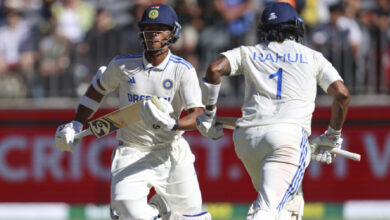Where to bowl in the IPL? Depends on boundary length

Rishabh Pant was exasperated. Shardul Thakur had been trying to force Kagiso Rabada to hit to the longer boundary, but his slower one had arrived around off- stump, and the South African had swatted him easily over the shorter deep-midwicket rope. From behind the stumps, the Delhi Capitals skipper pushed hard with both hands towards the longer offside, imploring Thakur to shift the line further away from Rabada.
The very next ball, Thakur got it right, pitching the cutter on off and getting it to slant across much wider. In no position to pull now, Rabada ended up slapping it straight to wide long-off on the farther rope. The last threat gone, DC wrapped up a crucial 17-run win over Punjab Kings at DY Patil Stadium on Monday.
The difference between the boundaries on the edges of the ‘V’ was around 6-7 metres in that game. The gap between the square ropes on either side of the pitch was almost double, at 13 metres.
Five pitches at each ground have been used during this Indian Premier League round-robin stage, and the boundary dances differ the most when pitches at either end of the square are used.
In a highly tactical format where teams try to squeeze out tiny advantages wherever they can, this substantial variation in boundary sizes has a big say in how a T20 game plays out, and often, in determining its outcome. The fundamental approach obviously is for the batting team to target the shorter side and for the fielding team to make that as hard as it can, mainly bowling towards the longer side.
That is what Anrich Nortje did on Monday, for instance, bowling a short, quick ball into Jonny Bairstow, who’s pull could not clear deep backward square leg on the dant boundary. But like with so many innovations in T20, the basic ploy has given rise to its own variations and responses from both batsmen and bowlers.
Buttler’s precise attack
On April 2 in a game between Rajasthan Royals and Mumbai Indians, the pitch at the other end of the DY Patil square was being used. And MI had got their plans worked out. Their two left-arm pacers, Tymal Mills and Daniel Sams, bowled their four overs each from the Pavilion End, their angle taking the ball away from the right-hander towards the longer off-side. But then, Buttler had already caused maximum damage.
In the fourth over, he took apart Basil Thampi with a sequence of four, six, six, four and six. Four out of Buttler’s five hits were to the shorter boundary, between deep midwicket and long-on.
Thampi was so stunned he didn’t even try making Buttler hit to the farther side. Buttler rode on that momentum to make a match-winning century.
Still, the boundary differences would keep Buttler wary at the innings break. “I’m a bit nervous as it is hard to tell if it is a good score or not with the short boundary one side,” Buttler had said.Too predictable
Conversely, batsmen can pre-meditate their shots if the bowler is constantly bowling wide on the longer side. Rahul Chahar and Harpreet Brar were spinning it away outside off to Mitchell Marsh on Monday, and the Australian eventually cut them for fours to the dant square rope, despite the presence of a sweeper.
Even Jasprit Bumrah couldn’t escape punishment against KL Rahul on the easternmost surface at Wankhede Stadium on April 24. Rahul read a wide yorker correctly to slice it to the left of deep point on the longer rope. And when Bumrah put more men in that area, Rahul went to the right of deep point for four more. But then, against someone of Bumrah’s class, it took the class of Rahul to breach the longer boundaries.
One-trick ploy
Andre Russell can bowl a mean short ball when he wants to, and against Gujarat Titans at DY Patil Stadium, he simply kept doing that, angling it into the batsmen’s bodies. The easternmost pitch was in use once more, and it was all but impossible for the GT batsmen to clear deep midwicket on the far western side against Russell’s bite. They gave three catches to Rinku Singh in that position in that one Russell over alone.
Bluff and bait
This looks best when it comes off from a spinner, although Arshdeep Singh is a frequent practitioner of the bluff; he’ll set a field to protect the longer boundary and then, looking for a miscue, try to induce the batsmen to hit his slower ones to the shorter rope.
Rashid Khan enticed Venkatesh Iyer to slog over the nearer midwicket boundary at DY Patil; the left-hander went for it, but it was a googly, and Venkatesh was caught on the edge of the fence. Ravichandran Ashwin lured a set Tilak Varma to go for the same boundary with a loopy delivery that belonged to Test cricket; the young left-hander took the bait, only to be bowled.
Perhaps the best example of a bluff came during Yuzvendra Chahal’s hat-trick against Kolkata Knight Riders at Brabourne Stadium. One square boundary was so far that Buttler had run four runs earlier. Chahal began wide towards that side to a rampaging Shreyas Iyer, but then slipped one fuller and quicker into the pads.
Shreyas was not expecting that line at all, given how tamely he fell leg-before.
Prasidh Krishna was bowling round the stumps at Wankhede, angling it across Liam Livingstone to the longer off-side protected a fly slip, third man, deep point, sweeper cover, extra cover and mid-off.Against such a telegraphed line of attack, Livingstone took his stance where the sixth stump would be, happy to leave all three stumps unguarded.
After copping a few boundaries, Krishna did something he should have done much earlier. He ran in and went full and straight. Livingstone couldn’t do anything as the yorker crashed into the stumps behind his back.
Stretching T20 tactics to the extreme can be unintentionally entertaining at times.







